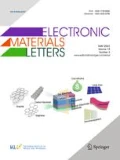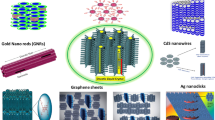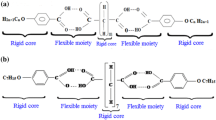Abstract
Liquid crystal (LC) has long been a feature in Materials Science and Nanotechnology, have recently been extended into the appealing domain of complex hybrid materials. The crystalline structural effects of alkoxy chain lengths and the mesogen properties of hydrogen-bonded (n-OBASA) complexes (n = 5,6,7) have been investigated in recent studies. The LC-based hybrid nanocomposite materials–obtained by the homogeneous dispersion of zinc oxide nanowires (ZnO NWs) as a dopant into hydrogen-bonded liquid-crystalline compounds—seem to be particularly promising in this article. Optimizing the geometry of surface stabilizing electro-optic, LC cell reveals the typical intermolecular hydrogen bond (H-bond) formation. Here, we explore molecular-colloidal hybrid composite matrix formed from LCs and dilute dispersions of orientation-ordered ZnO NWs, for eventual potential application in smart switchable display devices. In addition, we investigated the structural, dielectric and optical properties of the nanocomposite, and electro-optical studies which were performed by exploiting the potential during the conditions before the opening of spectrum acquisition. Our novel findings confirm that the electric field induces a charge transfer of the LC molecules to the nanomaterial, which acts as a trap for ionic charges. This effect may be utilized to achieve superior switching operation that is electro-optically tunable. Such dynamic novel switching could be harnessed in smart LCD technology and pave the way towards innovative display modulation techniques.
Graphical abstract














Similar content being viewed by others
References
Kato, T., Mizoshita, N., Kishimoto, K.: Functional liquid-crystalline assemblies: self-organized soft materials. Angew. Chem. Int. Ed. 45(1), 38–68 (2006)
Goodby, J.W., et al.: Transmission and amplification of information and properties in nanostructured liquid crystals. Angew. Chem. Int. Ed. 47(15), 2754–2787 (2008)
Tschierske, C.: Liquid crystal engineering–new complex mesophase structures and their relations to polymer morphologies, nanoscale patterning and crystal engineering. Chem. Soc. Rev. 36(12), 1930–1970 (2007)
Newsome, C., et al.: Laser etched gratings on polymer layers for alignment of liquid crystals. Appl. Phys. Lett. 72(17), 2078–2080 (1998)
Kagajyo, T., et al.: Alignment of nematic liquid crystal molecules using nanometer-sized ultrafine patterns by electron beam exposure method. Jpn. J. Appl. Phys. 44(1S), 578 (2005)
Varghese, S., et al.: Microrubbing technique to produce high pretilt multidomain liquid crystal alignment. Appl. Phys. Lett. 85(2), 230–232 (2004)
Rüetschi, M., et al.: Creation of liquid crystal waveguides with scanning force microscopy. Science 265(5171), 512–514 (1994)
Suh, D., Choi, S.J., Lee, H.H.: Rigiflex lithography for nanostructure transfer. Adv. Mater. 17(12), 1554–1560 (2005)
Kim, S.R., et al.: Fabrication of polymeric substrates with well-defined nanometer-scale topography and tailored surface chemistry. Adv. Mater. 14(20), 1468–1472 (2002)
Park, H.-G., et al.: Homeotropic alignment of liquid crystals on a nano-patterned polyimide surface using nanoimprint lithography. Soft Matter 7(12), 5610–5614 (2011)
Bouteiller, L., Barny, P.L.: Polymer-dispersed liquid crystals: preparation, operation and application. Liq. Cryst. 21(2), 157–174 (1996)
Spruce, G., Pringle, R.: Polymer dispersed liquid crystal (PDLC) films. Electron. Commun. Eng. J. 4(2), 91–100 (1992)
Crawford, G.P., Zumer, S.: Liquid Crystals in Complex Geometries: Formed by Polymer and Porous Networks. CRC Press, Boca Raton (2014)
Armitage, D., Underwood, I., Wu, S.-T.: Introduction to Microdisplays, vol. 11. Wiley, Hoboken (2006)
Crawford, G.: Flexible Flat Panel Displays, p. 290. Wiley, Chichester (2005)
Hinojosa, A., Sharma, S.C.: Effects of gold nanoparticles on electro-optical properties of a polymer-dispersed liquid crystal. Appl. Phys. Lett. 97(8), 081114 (2010)
Bozhevolnyi, S.I., Universitet, A., Shalaev, V.: Nanophotonics with surface plasmons-Part I. Photonics Spectra 40(1), 58 (2006)
Shalaev, V.M.: Nanophotonics with Surface Plasmons—Part ll. Photonics Spectra (2006)
Barnes, W.L., Dereux, A., Ebbesen, T.W.: Surface plasmon subwavelength optics. Nature 424(6950), 824 (2003)
Pal, K., et al.: Design, synthesis and application of hydrogen bonded smectic liquid crystal matrix encapsulated ZnO nanospikes. J. Mater. Chem. C 3(45), 11907–11917 (2015)
Pal, K., et al.: Influence of ZnO nanostructures in liquid crystal interfaces for bistable switching applications. Appl. Surf. Sci. 357, 1499–1510 (2015)
Pal, K., et al.: Optical and electrical investigation of ZnO nano-wires array centre micro-flowers turn to hierarchical nano-rose structures. J. Nanosci. Nanotechnol. 15, 1–10 (2016)
Pal, K., et al.: Synthetic strategy of porous ZnO and CdS nanostructures doped ferroelectric liquid crystal and its optical behavior. J. Mol. Struct. 1035, 76–82 (2013)
Jiao, M., et al.: Alignment layer effects on thin liquid crystal cells. Appl. Phys. Lett. 92(6), 061102 (2008)
Lu, S.-Y., Chien, L.-C.: Carbon nanotube doped liquid crystal OCB cells: physical and electro-optical properties. Opt. Express 16(17), 12777–12785 (2008)
Toney, M.F., et al.: Near-surface alignment of polymers in rubbed films. Nature 374(6524), 709 (1995)
Orbitals, I.F.F.: Organic Chemical Reactions. Wiley, New York (1976)
Ginzburg, V.: Some remarks on phase transitions of the second kind and the microscopic theory of ferroelectric materials. Soviet Phys. Solid State 2, 1824–1834 (1961)
Berlyand, L.: Homogenization of the Ginzburg-Landau functional with a surface energy term. Asymptot. Anal. 21(1), 37–59 (1999)
Bethuel, F., Brezis, H., Hélein, F.: Ginzburg-Landau Vortices, vol. 13. Springer, Berlin (1994)
Meyer, R.B., et al.: Equilibrium size and textures of islands in free-standing smectic C* films. Mol. Cryst. Liq. Cryst. Sci. Technol. Sect. A Mol. Cryst. Liq. Cryst. 364(1), 123–131 (2001)
Ericksen, J.L.: Liquid crystals with variable degree of orientation. Arch. Ration. Mech. Anal. 113(2), 97–120 (1991)
Pal, K., et al.: Functionalized graphene oxide dispersed hydrogen bonded liquid crystals efficient electro-optical switching. J. Display Technol. 12(3), 281–287 (2016)
Pal, K., et al.: Efficient one-step novel synthesis of ZnO nanospikes to nanoflakes doped OAFLCs (W-182) host: optical and dielectric response. Appl. Surf. Sci. 280, 405–417 (2013)
Vijayakumar, V., Murugadass, K., Mohan, M.: Inter hydrogen bonded complexes of hexadecylaniline and alkoxy benzoic acids: a study of crystallization kinetics. Braz. J. Phys. 39(3), 600–605 (2009)
Nakamoto, K., Nakamoto, K.: Infrared and Raman Spectra of Inorganic and Coordination Compounds. Wiley, Hoboken (1977)
Vijayakumar, V., Madhu Mohan, M.: Experimental evidence of an optical shutter in cholesteric phase of a double hydrogen bonded liquid crystal. Braz. J. Phys. 39(4), 677–683 (2009)
Guthrie, R.D.: Introduction to Spectroscopy (Pavia, Donald; Lampman, Gary M.; Kriz, George S., Jr.). ACS Publications, Washington (1979)
AL-TURKI, A.M.: Effect of preparation methods on the particles size, dielectric constant and antibacterial properties of ZnO nanoparticles and thin film of ZnO/Chitosan. Orient. J. CHEM. 34(1), 548–554 (2018). https://doi.org/10.13005/ojc/340163
Hsu, S.C., et al.: Effect of the polyimide structure and ZnO concentration on the morphology and characteristics of polyimide/ZnO nanohybrid films. Macromol. Chem. Phys. 206(2), 291–298 (2005)
Wu, C., et al.: Morphology-controllable graphene–TiO 2 nanorod hybrid nanostructures for polymer composites with high dielectric performance. J. Mater. Chem. 21(44), 17729–17736 (2011)
Ahmad, K., Pan, W., Wu, H.: High performance alumina based graphene nanocomposites with novel electrical and dielectric properties. RSC Adv. 5(42), 33607–33614 (2015)
Jammula, R.K., et al.: Strong interfacial polarization in ZnO decorated reduced-graphene oxide synthesized by molecular level mixing. Phys. Chem. Chem. Phys. 17(26), 17237–17245 (2015)
Wang, D., et al.: Functionalized graphene–BaTiO 3/ferroelectric polymer nanodielectric composites with high permittivity, low dielectric loss, and low percolation threshold. J. Mater. Chem. A 1(20), 6162–6168 (2013)
Roy, A.K., et al.:, Electrical Properties and AC Conductivity of (Bi 0.5 Na 0.5) 0.94 Ba 0.06 TiO 3 Ceramic. ISRN Ceramics (2012)
Almond, D.P., Bowen, C.: Anomalous power law dispersions in ac conductivity and permittivity shown to be characteristics of microstructural electrical networks. Phys. Rev. Lett. 92(15), 157601 (2004)
Bowen, C., Almond, D.P.: Modelling the’universal’dielectric response in heterogeneous materials using microstructural electrical networks. Mater. Sci. Technol. 22(6), 719–724 (2006)
Raghasudha, M., Ravinder, D., Veerasomaiah, P.: Influence of Cr3 + Ion on the Dielectric Properties of Nano Crystalline Mg-Ferrites Synthesized by Citrate-Gel Method. Materials Sciences and Applications 04(07), 7 (2013)
Miller, S., et al.: Device modeling of ferroelectric capacitors. J. Appl. Phys. 68(12), 6463–6471 (1990)
Miller, S., et al.: Modeling ferroelectric capacitor switching with asymmetric nonperiodic input signals and arbitrary initial conditions. J. Appl. Phys. 70(5), 2849–2860 (1991)
Yang, P., et al.: Electrical properties of SrBi 2 Ta 2 O 9 ferroelectric thin films at low temperature. Appl. Phys. Lett. 81(24), 4583–4585 (2002)
Si, G., et al.: Liquid-crystal-enabled active plasmonics: a review. Materials 7(2), 1296–1317 (2014)
Ma, R., et al.: Synthesis of CdS nanowire networks and their optical and electrical properties. Nanotechnology 18(20), 205605 (2007)
Acknowledgements
All the associate colleagues and doctoral scholars at Wuhan University, China should gratefully acknowledge by Prof. Kaushik Pal. Especially, sincere thanks to my Bachelor/Masters students, technitians and scientific operators, as well as entire teams of research members should acknowledge during “BK-21 Visiting Scientist” associate position in South Korea. We are grateful to our co-workers Prof. Madhu Mohan and Dr. P. Subhapriya from Liquid Crystals Research Laboratory, BIT Sathyamangalam encouraged for liquid crystal preparation and molecular dynamics performed by ‘Gaussian’ simulation. Sincere ‘Thanks’ will go to Dean (Research) at BIHER, Chennai provides excellence of the research laboratory foundation and co-operation of existing Nanotechnology laboratory. All scientific members are gratefully acknowledged for giving scopes to develop research ideas and scientific innovations. The author M. Abd Elkodous is also grateful to Prof. Radwan (Dean- Research), for giving research friendly scopes at Nile University in Egypt.
Author information
Authors and Affiliations
Corresponding author
Ethics declarations
Conflict of interest
All the authors have declared that, there is no conflict of any financial interests or authorship to publish the article.
Rights and permissions
About this article
Cite this article
Pal, K., Sajjadifar, S., Abd Elkodous, M. et al. Soft, Self-Assembly Liquid Crystalline Nanocomposite for Superior Switching. Electron. Mater. Lett. 15, 84–101 (2019). https://doi.org/10.1007/s13391-018-0098-y
Received:
Accepted:
Published:
Issue Date:
DOI: https://doi.org/10.1007/s13391-018-0098-y




